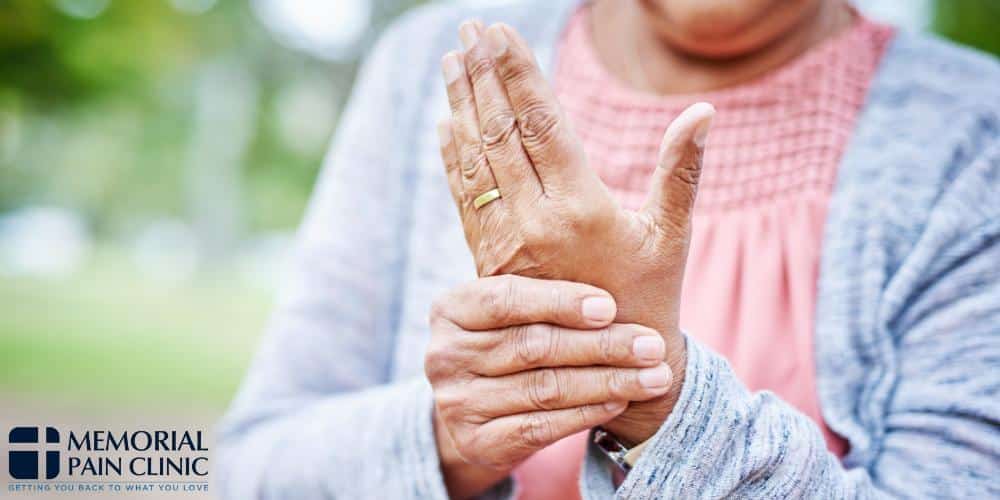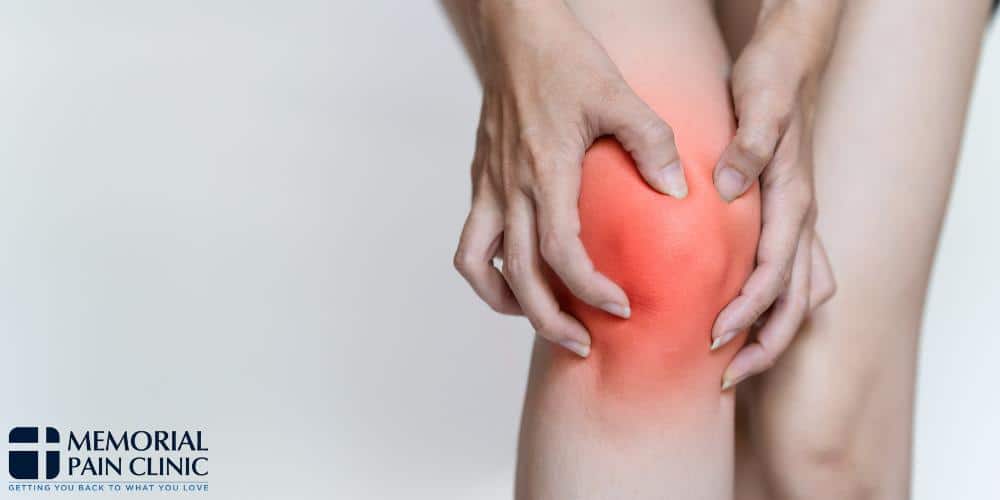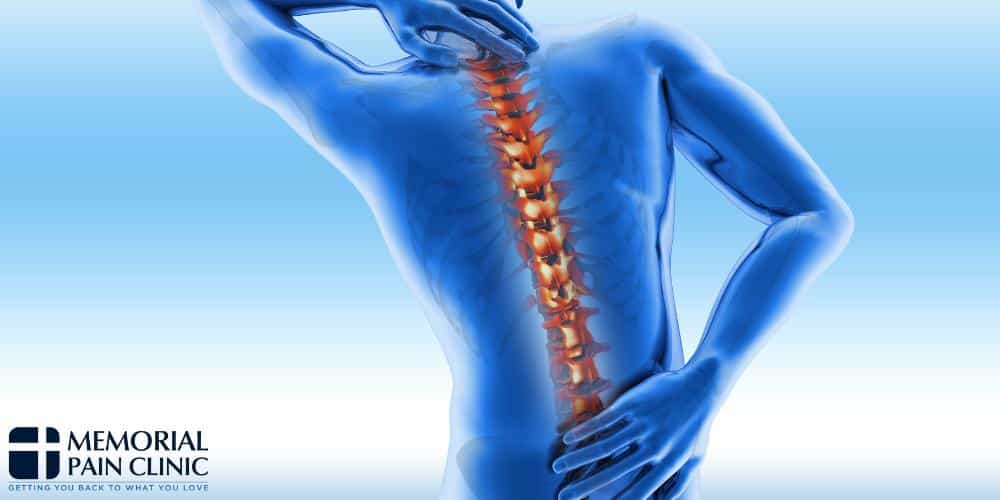Arthritis Treatment Tulsa, OK
Our Services
Arthritis Doctor in Tulsa, OK

At our clinic in Tulsa, Oklahoma, we understand the debilitating effects that arthritis can have on your daily life. That’s why we’re dedicated to providing personalized, effective, and compassionate care to help you find relief and regain control.
Whether you’re seeking information on various arthritis treatment options, lifestyle modifications, or expert advice on managing your arthritis symptoms, you’ve come to the right place. Join us as we explore the latest advancements in arthritis care and empower you to live a fulfilling, pain-free life.
To schedule an appointment with us, please call our Tulsa pain management clinic at 918-200-9944 today.
What Is Arthritis?
Arthritis is a broad term used to describe inflammation and stiffness of the joints. It encompasses over 100 different types of joint diseases and conditions, with the two most common being osteoarthritis and rheumatoid arthritis. Osteoarthritis occurs when the protective cartilage that cushions the ends of the bones wears down over time, leading to pain, swelling, and reduced mobility in the affected joints.
Rheumatoid arthritis, on the other hand, is an autoimmune disorder in which the body’s immune system mistakenly attacks the synovium, the lining of the membranes that surround the joints, causing inflammation, pain, and eventually joint damage.
Arthritis can affect people of all ages and backgrounds and can significantly impact their quality of life if left untreated. However, with proper management and treatment, many individuals with arthritis can effectively control their symptoms and lead active, fulfilling lives.
Types of Arthritis
Arthritis encompasses a broad spectrum of conditions characterized by inflammation and stiffness in the joints. By understanding which type of arthritis you have, we can more effectively help you manage pain. Among the most common types of arthritis are rheumatoid arthritis, psoriatic arthritis, septic arthritis, reactive arthritis, inflammatory arthritis, degenerative arthritis, osteoarthritis, and gout.
Rheumatoid Arthritis
Rheumatoid arthritis (RA) is an autoimmune disorder where the body’s immune system mistakenly attacks the synovium, the lining of the membranes that surround the joints. This leads to inflammation, pain, and eventual joint damage. RA commonly affects the hands, wrists, and knees. Severe rheumatoid arthritis can cause systemic symptoms such as fatigue and fever.
Psoriatic Arthritis
Psoriatic arthritis is a type of arthritis that occurs in some people with psoriasis, a chronic autoimmune skin condition characterized by red, scaly patches. It can affect any joint in the body and cause inflammation, pain, and stiffness, often accompanied by skin symptoms.
Septic Arthritis
Septic arthritis occurs when a joint becomes infected, usually by bacteria. It can lead to rapid joint deterioration and severe pain, swelling, fever, and chills. Prompt treatment with antibiotics is crucial to prevent permanent joint damage.
Reactive Arthritis
Reactive arthritis is a form of arthritis that develops in response to an infection, typically in the gastrointestinal or genitourinary tract. It commonly affects the joints, causing pain, stiffness, and swelling, often accompanied by other symptoms like urinary or gastrointestinal issues.
Inflammatory Arthritis
Inflammatory arthritis refers to a group of conditions characterized by inflammation in the joints and surrounding tissues. This includes rheumatoid arthritis, psoriatic arthritis, and ankylosing spondylitis, among others. Inflammatory arthritis can cause joint pain, stiffness, swelling, and fatigue, and it often requires ongoing management to control symptoms and prevent joint damage.
Osteoarthritis (Degenerative Arthritis)
Osteoarthritis (OA), often referred to as degenerative arthritis, is the most prevalent form of arthritis. It occurs due to the breakdown of cartilage, the protective tissue that cushions the ends of bones in the joints. As cartilage wears away, bones can rub against each other, leading to pain, swelling, and stiffness. Osteoarthritis pain commonly affects weight-bearing joints like the knees, hips, and spine, and it typically develops gradually over time, often due to aging or repetitive joint use.
Gout
Gout is a type of arthritis caused by the buildup of uric acid crystals in the joints, leading to sudden and severe episodes of pain, swelling, redness, and warmth, often in the big toe. It occurs when the body produces too much uric acid or fails to excrete it properly. Certain foods high in purines, such as red meat and alcohol, can trigger gout attacks.
What Causes Arthritis?

Arthritis can have various underlying causes. The most common types, osteoarthritis and rheumatoid arthritis, have distinct origins. Osteoarthritis typically arises from the gradual breakdown of joint cartilage due to factors like aging, repetitive joint stress, injuries, or obesity. On the other hand, rheumatoid arthritis stems from an autoimmune response where the body’s immune system mistakenly attacks the synovium, the lining of joint membranes.
Other forms of arthritis, such as psoriatic arthritis and gout, can result from genetic predisposition, infections, metabolic disorders, or joint injuries. While the exact cause varies among individuals and types of arthritis, a combination of genetic, environmental, and lifestyle factors often contributes to its development. Understanding these underlying factors is crucial for effective management and treatment of arthritis symptoms.
Which Joints Most Often Develop Arthritis?
Arthritis can affect various joints in the body, but some are more commonly affected than others. Among the most frequently impacted joints are those in the hands, knees, hips, and back.
Arthritis in Hands
Arthritis in the hands is quite common, particularly osteoarthritis (OA) and rheumatoid arthritis (RA). OA in the hands often affects the joints at the base of the thumb, the joints closest to the fingertips, and the middle joints of the fingers.
These areas can develop bony growths, called osteophytes or bone spurs, leading to pain, stiffness, and reduced range of motion. RA, on the other hand, can affect multiple joints in the hands simultaneously, causing inflammation, swelling, and deformities such as joint erosion and deformities.
Knee Arthritis
Knee arthritis is prevalent, especially osteoarthritis. The knees are weight-bearing joints, making them susceptible to wear and tear over time. In osteoarthritis, the cartilage that cushions the ends of the bones in the knee joint gradually wears away, leading to pain, swelling, and stiffness. Knee arthritis can significantly impact mobility and quality of life, particularly in older adults.
Hip Arthritis
Arthritis in the hips is also common, primarily osteoarthritis but also sometimes rheumatoid arthritis. The hip joint is crucial for mobility and bears a significant amount of body weight. In osteoarthritis of the hip, the cartilage breaks down, causing pain, stiffness, and decreased range of motion.
As the condition progresses, bone spurs may form, further complicating movement and causing discomfort. In rheumatoid arthritis, inflammation can damage the hip joint, leading to pain, swelling, and difficulty walking.
Arthritis in Back
Arthritis in the back, particularly in the lower back or lumbar spine, is prevalent, often due to osteoarthritis or degenerative disc disease. Osteoarthritis can affect the small joints in the spine, leading to pain, stiffness, and reduced flexibility.
Degenerative disc disease involves the breakdown of the intervertebral discs, the soft cushions between the vertebrae, causing pain, numbness, and tingling in the back and legs. Arthritis in the back can significantly impact mobility and quality of life, affecting daily activities and overall well-being.
Arthritis Symptoms
The symptoms of arthritis can vary depending on the type and severity of the condition. However, common symptoms include:
- Joint pain
- Joint stiffness
- Swelling
- Reduced range of motion
- Joint deformities
- Fatigue
- Redness and warmth
- Weakness
It’s important to note that arthritis symptoms can fluctuate over time and may vary from person to person. Early detection and proper management are essential for minimizing discomfort, preventing further joint damage, and avoiding severe pain.
What Does Arthritis Feel Like?

Arthritis can manifest differently for each individual, but there are common symptoms that many people with arthritis experience. The sensations associated with arthritis typically include pain, stiffness, swelling, and reduced range of motion in the affected joints.
Pain is one of the most prevalent symptoms of arthritis and can vary in intensity from mild discomfort to severe and debilitating. Arthritis pain often worsens with movement or after periods of inactivity, such as upon waking in the morning. The pain may be described as dull, achy, sharp, or throbbing, depending on the type and severity of arthritis.
Stiffness is another hallmark of arthritis, particularly upon waking or after prolonged periods of rest. Joints affected by arthritis may feel stiff and difficult to move, leading to a sensation of tightness or limited mobility. This stiffness often improves with gentle movement and stretches but may return after periods of inactivity.
Swelling, or inflammation, is common in many types of arthritis, particularly rheumatoid arthritis and inflammatory arthritis. Swollen joints may appear red, warm to the touch, and visibly larger than usual. The swelling can contribute to pain and stiffness and may impair joint function.
Reduced range of motion is a significant feature of arthritis, as the condition can affect the flexibility and movement of the affected joints. Individuals with arthritis may find it challenging to perform everyday tasks that require bending, lifting, or reaching and may experience a sensation of joint “locking” or “catching” during movement.
In addition to these physical symptoms, arthritis can also have emotional and psychological effects. Chronic pain and physical limitations can impact mood, sleep, and overall quality of life, leading to feelings of frustration, anxiety, or depression in some individuals.
How Is Arthritis Diagnosed?
Diagnosing arthritis typically involves a combination of medical history, physical examination, imaging tests, and sometimes laboratory tests. Generally, after taking a medical history and physical examination, we do the following.
- Imaging tests: Imaging tests such as X-rays, magnetic resonance imaging (MRI), ultrasound, or computed tomography (CT) scans may be ordered to visualize the affected joints and assess the extent of joint damage, cartilage loss, bone spurs, and inflammation. These tests can help confirm a diagnosis of arthritis and differentiate between different types of arthritis.
- Laboratory tests: Blood tests may be ordered to detect specific markers of inflammation and autoimmune activity, such as C-reactive protein (CRP), erythrocyte sedimentation rate (ESR), rheumatoid factor (RF), anti-cyclic citrullinated peptide (anti-CCP) antibodies, and uric acid levels. These tests can help diagnose inflammatory types of arthritis like rheumatoid arthritis, gout, or systemic lupus erythematosus (SLE).
- Joint aspiration: In some cases, a procedure called joint aspiration or arthrocentesis may be performed to remove a small sample of joint fluid. The fluid is then analyzed for signs of inflammation, infection, or crystals (as seen in gout).
Is Arthritis Hereditary?
While the exact causes of arthritis are not fully understood, genetics do play a significant role in certain types of arthritis. Some forms of arthritis, such as rheumatoid arthritis (RA), psoriatic arthritis, and ankylosing spondylitis, have a known genetic component.
In the case of rheumatoid arthritis, for example, having a family history of the condition increases the risk of developing RA. Specific genetic markers, such as certain variations in the human leukocyte antigen (HLA) genes, have been associated with an increased susceptibility to autoimmune diseases like RA.
Similarly, psoriatic arthritis tends to run in families, and individuals with a family history of psoriasis or psoriatic arthritis are at higher risk of developing the condition themselves. Certain genetic factors, including variations in genes related to the immune system and inflammation, have been implicated in psoriatic arthritis.
Ankylosing spondylitis, a type of arthritis primarily affecting the spine and sacroiliac joints, also has a strong genetic component. The majority of individuals with ankylosing spondylitis carry a specific genetic marker called HLA-B27, although not everyone with this marker develops the condition.
How Is Arthritis Treated and Managed?
Arthritis treatments and management typically aim to alleviate symptoms, improve joint function, and slow the progression of the disease. The approach to treatment may vary depending on the type and severity of arthritis, as well as individual factors such as age, overall health, and lifestyle. Some common strategies for managing arthritis include:
- Medications
- Creams and ointments
- Corticosteroid medications
- Physical therapy
- Lifestyle modifications
- Joint protection
- Heat and cold therapy
- Stress management
- Surgery, including joint repair, replacement, and fusion
Arthritis Medication
Medications are commonly used to manage arthritis symptoms, relieve pain, and slow disease progression. Nonsteroidal anti-inflammatory drugs (NSAIDs), such as ibuprofen and naproxen, help relieve pain and reduce inflammation in many types of arthritis, including osteoarthritis and rheumatoid arthritis. Acetaminophen may also be used to alleviate discomfort in the painful joint, although it does not have anti-inflammatory effects.
For inflammatory types of arthritis like rheumatoid arthritis, psoriatic arthritis, and ankylosing spondylitis, disease-modifying antirheumatic drugs (DMARDs) are often prescribed. DMARDs work by suppressing the immune system and reducing inflammation to prevent joint damage. Common DMARDs include methotrexate, sulfasalazine, and hydroxychloroquine.
Biologic DMARDs, such as tumor necrosis factor (TNF) inhibitors, interleukin inhibitors, and Janus kinase (JAK) inhibitors, are another class of medications used to target specific molecules involved in the inflammatory process.
Arthritis Surgery
In cases where conservative treatments fail to relieve arthritis pain or when joint damage is severe, surgery may be considered. Joint replacement surgery, such as knee replacement, hip replacement, or shoulder replacement, can alleviate pain and restore function by replacing damaged joint surfaces with artificial implants. Other surgical procedures, such as arthroscopy, synovectomy, or joint fusion, may be performed to remove damaged tissue, reduce inflammation, or stabilize unstable joints.
How to Prevent Arthritis

While some factors contributing to arthritis, such as genetics and age, cannot be controlled, there are several steps individuals can take to reduce their risk of developing arthritis and manage symptoms effectively.
Practicing proper body mechanics and joint protection techniques can help prevent joint injury and reduce pain and inflammation. This includes using ergonomic tools and aids, avoiding repetitive movements that strain the joints, and using proper lifting techniques to reduce the risk of joint damage. Many patients work with a physical or occupational therapist to better understand how to reduce their risk of arthritis.
Arthritis Self-Care
Being overweight or obese increases the risk of developing arthritis, particularly osteoarthritis, as excess weight places added stress on weight-bearing joints such as the knees, hips, and spine. By maintaining a healthy weight through a balanced diet and regular exercise, individuals can reduce the strain on their joints and lower their risk of arthritis.
Regular physical activity is crucial for maintaining joint flexibility, muscle strength, and overall joint health. Low-impact exercises such as walking, swimming, cycling, and tai chi are gentle on the joints and can help reduce stiffness, improve mobility, and alleviate arthritis symptoms. It’s essential to choose activities that are enjoyable and sustainable to maintain long-term adherence.
Contact Our Tulsa, Oklahoma Arthritis Center Today for Joint Pain Relief
At Memorial Pain Clinic in Tulsa, Oklahoma, we understand the significant impact that arthritis can have on your quality of life. Our experienced team is dedicated to providing comprehensive and personalized arthritis treatments to help you manage pain, reduce inflammation, and improve joint function.
From medication management and injections to physical therapy and minimally invasive procedures, we offer a range of options tailored to your unique needs. With our compassionate care and advanced therapies, we strive to empower you to live your life to the fullest, free from the limitations of arthritis. Contact Memorial Pain Clinic today to learn more about how we can support you on your journey to better joint health.

